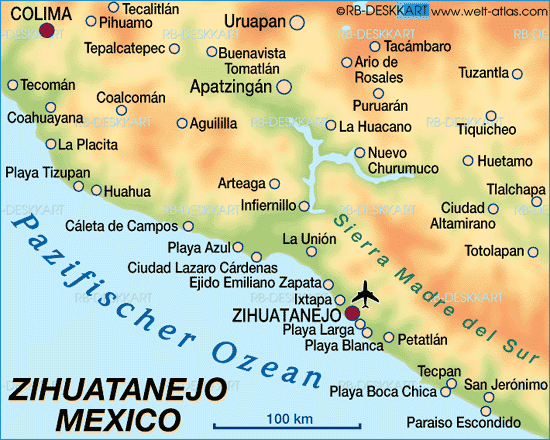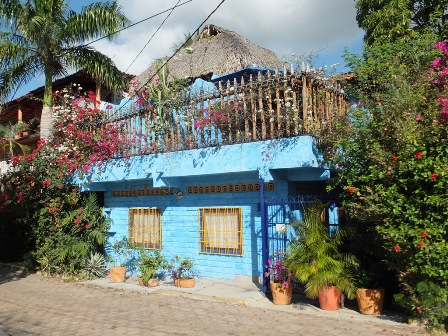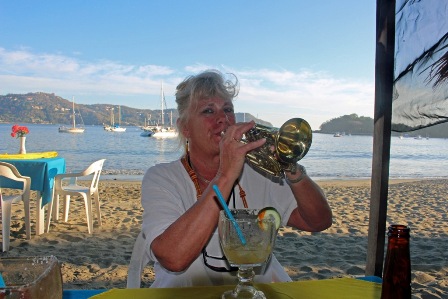
To return to this webpage, close the Picasa window
Read Yucatan or San Miguel de Allende
Feb 6-28 2015
What more could we ask
for; a beautiful beach, warm waters, good restaurants, local markets, a
comfortable room and, best of all, great neighbours. Three weeks in Zihuatanejo
went by so quickly that we are reserving for four weeks next year.
 Zihuatanejo, a fishing
village, at the head of the large Zihuatanejo Bay, with a backdrop of the
Southern Sierra Grande Mountains, is now very popular with tourists who come for
the beaches and calm waters.
We stayed in Casa Azul,
the blue house, (www.casaazul
–zihuatanejo.com ) a small three apartment house on a dead end street on a hill
above La Madera Beach, between the main town beach and long La Ropa beach on
Zihuatanejo Bay. Our apartment, El Nid (the nest), was the smallest, a compactly
designed studio. Our room was open to the elements on the front. It had a kitchen, bathroom, sitting area and dining
table under the
sun and moon on our open balcony. Ray said it reminded him of sleeping in the lean-tos in the Adirondacks
and how much he liked being wakened up to the sun streaming into our room,
unimpeded by windows and curtains. I got used to the early mornings and put
mosquito repellant on in the evening, as the nasty critters ignored Ray but
zeroed in on me. I even got used to music drifting into El Nid in the evening
from clubs in town and put my earplugs in for the Friday and Saturday
performances. Why do clubs think that music has to be played at maximum volume?
Zihuatanejo, a fishing
village, at the head of the large Zihuatanejo Bay, with a backdrop of the
Southern Sierra Grande Mountains, is now very popular with tourists who come for
the beaches and calm waters.
We stayed in Casa Azul,
the blue house, (www.casaazul
–zihuatanejo.com ) a small three apartment house on a dead end street on a hill
above La Madera Beach, between the main town beach and long La Ropa beach on
Zihuatanejo Bay. Our apartment, El Nid (the nest), was the smallest, a compactly
designed studio. Our room was open to the elements on the front. It had a kitchen, bathroom, sitting area and dining
table under the
sun and moon on our open balcony. Ray said it reminded him of sleeping in the lean-tos in the Adirondacks
and how much he liked being wakened up to the sun streaming into our room,
unimpeded by windows and curtains. I got used to the early mornings and put
mosquito repellant on in the evening, as the nasty critters ignored Ray but
zeroed in on me. I even got used to music drifting into El Nid in the evening
from clubs in town and put my earplugs in for the Friday and Saturday
performances. Why do clubs think that music has to be played at maximum volume?
But small complaints
didn’t prevent us from enjoying our stay. We established a beach routine that
had a bit of everything we like to do. After walking down the 77 steps to La
Madera beach we would claim a chair in our favourite beach side restaurant and
go for our swim. I liked to have a long swim almost the length of La Madera
beach and back, while Ray took his time swimming and floating contentedly in the
warm ocean. To dry off, we would have a long walk across the beach and back to
our chairs, order lunch and read our books. A second swim and walk would
complete our day. Add in chats with other tourists and it made for a very
relaxing day.
A crowd of people at the
La Madera shoreline signalled something unusual was happening. Ray met me at the
water’s edge as I finished my long swim and said an eel was in the surf near
shore. Sure enough, a small head appeared trying, unsuccessfully, to swim
against the small breakers. Some bigger children started to throw rocks at the
eel, fearing it might bite someone. I decided a rescue operation was warranted.
I went to the restaurant we frequent and asked to borrow a bucket. One of the
employees grabbed a spade, which I hoped he wouldn’t need, and followed me back
to the surf. I waded into the shallows where the eel was still attempting to get
to deeper waters and scooped the eel into the bucket. It was a small spotted
Moray Eel, about 18 inches long, with a lovely ruffled dorsal fin down its back.
Eels usually hide in a safe rock crevice, occasionally poking their heads out.
The only other times I had seen an eel was snorkeling over corals. I wanted to
take the eel to the rocks at the far end of the beach, where eels had been
previously sighted, and let it go so it could find a safe place to hide.
Everybody on the beach wanted to have a look at the captive, who at least wasn’t
trying to climb out of the bucket. After everyone had had a turn to admire the
eel, Ray and I carried the bucket over to the rocks where we tried to find the
best place to liberate it. We chose a small channel running to the sea and
dumped it out. Immediately it started swimming towards the open water, only to
get washed back with the next wave. The rocks are also the favourite spot for
fishermen to come foraging for oysters and one was busy scraping off the
molluscs nearby. We finally left, praying the eel would escape before the
fisherman decided to catch and kill it. I never saw an eel body floating around,
so perhaps our rescue attempt was successful.
We did visit a few of the
other beaches on Zihuatanejo Bay. We made the trek up one hill and down another
that took us over the rocky point separating La Madera Beach from La Ropa Beach.
There we followed the same routine, with perhaps a longer swim and a longer
beach walk. We even extended one La Ropa visit by clamouring over a rocky path
to Las Gatas Beach, the last beach on the deep Zihuatanejo Bay, where there were
some coral outcrops to explore. We didn’t get bored.
We always enjoy visiting
local markets and the large Central market in Zihuatanejo sold almost everything
we needed to cook our meals. We especially liked the variety of fruits and
vegetables available and the fresh fish for sale. One day we followed the
walkway from La Madera, past the length of the town beach to the Municipal pier,
just in time to see the fishing boats arrive after a day of fishing with
clients. It must have been a good day, for three boats were unloading huge
Sailfish, recognizable by their large, erect dorsal fin, the sail and their
long, sharp bill, similar to a swordfish. One successful fisherman posed with
his catch, hoisted up by their tail to be weighed and measured. The fisherman
credited with the catch may take home enough fish for a meal but the majority of
the is given to the boat captain and much of that catch ends up in the market,
where we were more than happy to by a small portion for our dinner.
We met several fellow
tourists who became good friends. Bill and Susan Calkin, from Colorado, were the
newlyweds right next to our El Nid room. Bill is the former owner of Casa Azul
with the agreement of the current owner that his all-time favourite suite,
Arriba (upstairs) for February and March. Bill and Susan found each other later
in life when Bill started taking piano lessons from Susan, and they got married last
December 31. The third apartment, Abajo (below) was occupied by Marilyn and Mike
Meeker, a delightful couple from Minnesota. Our friend Morris Davison would be
interested to hear that Mike is a Thai-chi enthusiast. We knew he was doing a
work out on the back patio whenever we heard the soothing strains of music he
used to accompany his routines.
 Susan came with Bill for
the first time last year and visited the local primary school with the view of
returning this year and volunteering her services as a music teacher. Susan
arrived this year with 30 recorders with which she taught a grade 5 class how to
play. Marilyn, a former teacher, jumped at the chance to be an assistant to
Susan, even though she had to learn to play the recorder along with the
children. Susan also brought along a ukulele and a miniature horn, hoping to
join in with ever group would have her. Susan
brought along her horn one
afternoon when we met then for drinks in one of the restaurants lining the town
beach. Sure enough roving musicians stopped at our table and Susan asked if she
could play with them. They agreed, knowing we would tip them well, and play
Susan did. The guitarist was able to follow her but the poor accordionist didn’t
have a large enough range on his instrument to keep up. It worked out well for
all, but that was not enough for Susan. She found a local band, directed by a
young man from Mexico City, and consisting of mostly expats longing to keep up
their musical talents. From then on, twice weekly practises with her horn were added to the
recorder lessons in the school.
Susan came with Bill for
the first time last year and visited the local primary school with the view of
returning this year and volunteering her services as a music teacher. Susan
arrived this year with 30 recorders with which she taught a grade 5 class how to
play. Marilyn, a former teacher, jumped at the chance to be an assistant to
Susan, even though she had to learn to play the recorder along with the
children. Susan also brought along a ukulele and a miniature horn, hoping to
join in with ever group would have her. Susan
brought along her horn one
afternoon when we met then for drinks in one of the restaurants lining the town
beach. Sure enough roving musicians stopped at our table and Susan asked if she
could play with them. They agreed, knowing we would tip them well, and play
Susan did. The guitarist was able to follow her but the poor accordionist didn’t
have a large enough range on his instrument to keep up. It worked out well for
all, but that was not enough for Susan. She found a local band, directed by a
young man from Mexico City, and consisting of mostly expats longing to keep up
their musical talents. From then on, twice weekly practises with her horn were added to the
recorder lessons in the school.
Another activity was
added to our daily routine. Bill was a bridge player and Susan wanted to be a
capable partner. The problem was she had never played any card games at all. Her
musical family spent their time with sing songs and making music with their
multitude of instruments. Susan needed to start learning from scratch, including
the names of the suits and why one suit was more dominant than another. Every
afternoon we four got together for one or two hours of beginner bridge lessons.
Susan was thrilled and worked hard to remember everything we taught her. We
recommended some of Audrey Grant’s bridge books that are popular in Ottawa and
suggested she find a Beginner Bridge class back in Colorado to strengthen her
new skills. We expect to hear that Susan and Bill succeed in playing with
friends in their home town. We will also expect to continue our lessons next
year. It certainly made Ray and I review all our bidding and playing rules.
Ray and I are not true birders, but we
especially enjoy seeing and identifying birds that we don’t normally see at
home. Ray had bought a Peterson Bird Guide for North American app for his mini
iPad. That gave us a great start identifying the shore birds that searched for
food along the shoreline on the beach every day. We had to branch out and Google
the internet for Mexican Birds to identify a pair of large birds that lived
behind Casa Azul. They turned out to be West Mexican Chacalacas, members of the
chicken, or wild turkey family. They had made a nest in one of the large trees
in our backyard and laid eggs, but we don’t think they were very successful in
raising any chicks. Raucous clucks would alert us to the fact that other birds
were raiding their nest. Despite brave attempts by the Chachalacas to scare the
intruders off, we think a gang of the Yellow-headed Blackbirds won, as there
were broken egg shells on the path.
We were so content with
our swim routine that we hadn’t given any thought to going on a day trip
anywhere else. That is, until almost the last day when the recommendation of a
Wildlife Refuge Center at Barra de Potosi, a short ride down the coast, sparked
our interest. Off we went on the local bus the next morning to Los Achotes, a
small town 25 km from Zihua. Six gringos from Zihua piled into the back of a
converted truck with benches along the sides of the back heading to Barra de
Potosi Beach. I told the driver to
let us off at the Refuge center and he did. It looked like a large property, all
fenced off but there was no one around and the gates were locked. I rang a bell,
repeatedly and called out until finally a worker arrived. He looked at us and
went to get the owner. That is when we found out the Wildlife Center was closed,
and had been for a year. The owner was busy giving an art class to 13
participants but she did arrange for a worker to drive us to the beach, as it
would be another 45 or more minutes for another bus-truck to come along. At
least I had brought my bathing suit in case we had time to head to the beach
after the Refuge Center, but Ray did not have his. Once at the beach, a very
long expanse of white sand with an entrance to a lagoon at one end, we found
chairs at a one of the beach restaurants and went for a walk. There were lots of
beach restaurants, but few people on a Monday, but many wading birds and terns
along the shore of the lagoon to photograph. Ray was able to buy an inexpensive
suit to wear, the swimming was good and the food just right for lunch, so the
day turned out well, despite. Next time we will check on the internet before
heading out on a day trip.
|
Read 2015 Yucatan or San Miguel de Allende |
Return to Mexico Intro
Return to Travels
Return to Introduction